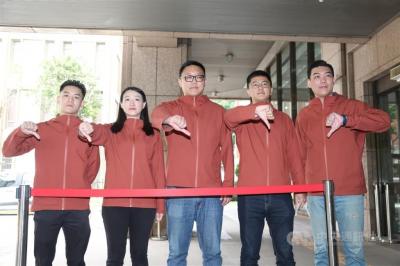Taiwan's military flexed its muscle yesterday with a fleet of attack helicopters and heavy artillery demonstrating their determination to fend off any attack on a beach facing China.
Eight AH-1W attack helicopters and as many OH-58D Scout helicopters were shown on television firing missiles, rockets and guns at targets in a drill simulating a Chinese invasion on a beach in western Taiwan.
M-109 self-propelled cannons and M-110 eight-inch howitzers, as well as F-16 fighters and Seagull fastboats armed with anti-ship missiles were mobilized in the exercise, which is part of Taiwan's biggest annual manoeuvres code named "Han Kuang 20."
Last week around 5,000 troops took part in exercises on the south coast simulating an attempt to repel a beach landing.
Two air force Mirage 2000-5 jets also landed on major freeways in an exercise to "review the air force's capability in using freeways for emergency landings and logistic support in case of war."
The exercises come amid growing tensions with China.
New Defense Minister Lee Jye (李傑) said all the armed forces' various strategies needed to be "verified" through drills, which will climax when President Chen Shui-bian (陳水扁) presides over major war games slated for August 25 in southern Pingtung County.
Separately, Chen visit Taiwan's two Dutch-built Sword Dragon-class submarines today during a cruise off the main naval base in Tzuoying, in southern Kaohsiung county, the navy said.
Some parliamentarians criticized the high-profile visit as provocative at this juncture, but others said it was aimed to underscore the importance of the eight conventional submarines the United States has offered to sell to Taiwan.
The submarine deal is at the heart of a controversial special budget of 610 billion Taiwan dollars (18.2 billion US) to buy advanced weaponry, including modified Patriot anti-missile systems and anti-submarine aircraft, over a 15-year period from 2005.
The draft budget is pending parliament's final approval.
The navy says the submarines are critical to counter China's naval buildup.
Taiwan's display of military muscle comes after the China News Service said Monday China had held a military exercise in its southeastern province of Fujian as part of stepped up preparedness for conflict with the island, which it regards as part of its territory.
More than 3,000 troops took part in the war games.

Taiwan is stepping up plans to create self-sufficient supply chains for combat drones and increase foreign orders from the US to counter China’s numerical superiority, a defense official said on Saturday. Commenting on condition of anonymity, the official said the nation’s armed forces are in agreement with US Admiral Samuel Paparo’s assessment that Taiwan’s military must be prepared to turn the nation’s waters into a “hellscape” for the Chinese People’s Liberation Army (PLA). Paparo, the commander of the US Indo-Pacific Command, reiterated the concept during a Congressional hearing in Washington on Wednesday. He first coined the term in a security conference last

Prosecutors today declined to say who was questioned regarding alleged forgery on petitions to recall Democratic Progressive Party (DPP) legislators, after Chinese-language media earlier reported that members of the Chinese Nationalist Party (KMT) Youth League were brought in for questioning. The Ministry of Justice Investigation Bureau confirmed that two people had been questioned, but did not disclose any further information about the ongoing investigation. KMT Youth League members Lee Hsiao-liang (李孝亮) and Liu Szu-yin (劉思吟) — who are leading the effort to recall DPP caucus chief executive Rosalia Wu (吳思瑤) and Legislator Wu Pei-yi (吳沛憶) — both posted on Facebook saying: “I

The Ministry of Economic Affairs has fined Taobao NT$1.2 million (US$36,912) for advertisements that exceed its approved business scope, requiring the Chinese e-commerce platform to make corrections in the first half of this year or its license may be revoked. Lawmakers have called for stricter enforcement of Chinese e-commerce platforms and measures to prevent China from laundering its goods through Taiwan in response to US President Donald Trump’s heavy tariffs on China. The Legislative Yuan’s Finance Committee met today to discuss policies to prevent China from dumping goods in Taiwan, inviting government agencies to report. Democratic Progressive Party Legislator Kuo Kuo-wen (郭國文) said

The Ministry of Economic Affairs has fined Taobao NT$1.2 million (US$36,900) for advertisements that exceeded its approved business scope and ordered the Chinese e-commerce platform to make corrections in the first half of this year or its license would be revoked. Lawmakers have called for stricter supervision of Chinese e-commerce platforms and more stringent measures to prevent China from laundering its goods through Taiwan as US President Donald Trump’s administration cracks down on origin laundering. The legislature’s Finance Committee yesterday met to discuss policies to prevent China from dumping goods in Taiwan, inviting government agencies to report on the matter. Democratic Progressive Party